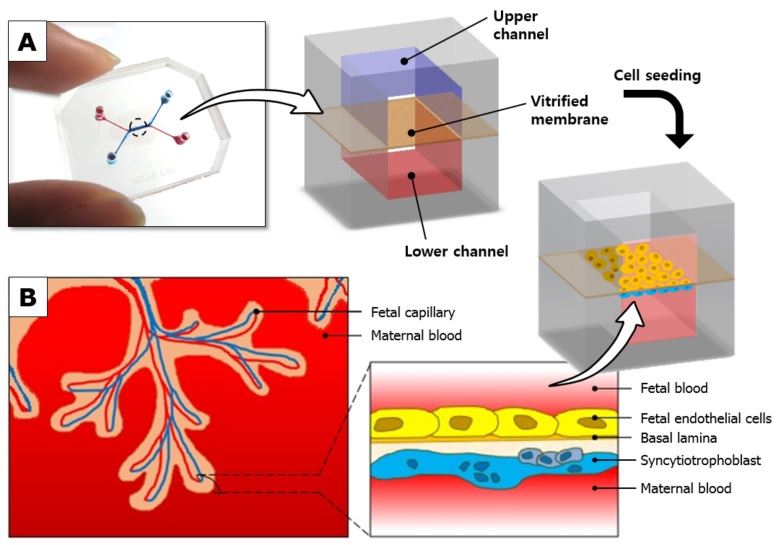Researchers Design Placenta-on-a-Chip to Better Understand Pregnancy

NIH team and colleagues believe microdevice may improve upon existing placenta models
National Institutes of Health (NIH) researchers and their colleagues have developed a “placenta-on-a-chip” to study the inner workings of the human placenta and its role in pregnancy. The device was designed to imitate, on a micro-level, the structure and function of the placenta and model the transfer of nutrients from mother to fetus. This prototype is one of the latest in a series of organ-on-a-chip technologies developed to accelerate biomedical advances.
The study, published online in The Journal of Maternal-Fetal & Neonatal Medicine, was conducted by an interdisciplinary team of researchers from the NIH’s Eunice Kennedy Shriver National Institute of Child Health and Human Development (NICHD), the University of Pennsylvania, Wayne State University/Detroit Medical Center, Seoul National University and Asan Medical Center in the Republic of South Korea.
“We believe that this system may be used to address questions which are difficult to answer with the current placenta model systems and serve to enable research in pregnancy and its complications,” said Dr. Romero, Chief of the Perinatology Research Branch of the Division of Intramural Research of NICHD.
The placenta is a temporary organ that develops in pregnancy and is the major interface between mother and fetus. Among its many functions is to serve as a “crossing guard” for substances traveling between mother and fetus. The placenta helps nutrients and oxygen move to the fetus and helps waste products move away. At the same time, the placenta tries to stop harmful environmental exposures, like bacteria, viruses and certain medications, from reaching the fetus. When the placenta doesn’t function correctly, the health of both mom and baby suffers.
Researchers are trying to learn how the placenta manages all this traffic, transporting some substances and blocking others. This knowledge may one day help clinicians better assess placental health and ultimately improve pregnancy outcome.
However, studying the placenta in humans is challenging: it’s time-consuming, subject to a great deal of variability, and potentially risky for the fetus. For those reasons, previous studies on placental transport have relied in large on animal models and on laboratory-grown human cells. These methods have yielded helpful information, but are limited as to how well they can mimic physiological processes in humans.
The researchers created the placenta-on-a-chip technology to address these challenges, using human cells in a structure that more closely resembles the placenta’s maternal-fetal barrier. The device consists of a semi-permeable membrane between two tiny chambers, one filled with maternal cells derived from a delivered placenta and the other filled with fetal cells derived from an umbilical cord.
After designing the structure of the model, the researchers tested its function by evaluating the transfer of glucose (a substance made by the body when converting carbohydrates to energy) from the maternal compartment to the fetal compartment. The successful transfer of glucose in the device mirrored what occurs in the body.
“The chip may allow us to do experiments more efficiently and at a lower cost than animal studies,” said Dr. Romero “With further improvements, we hope this technology may lead to better understanding of normal placental processes and placental disorders.”
Figure: A placenta-on-a-chip microdevice: A) The device’s upper (blue) and lower (red) chambers are separated by a semi-permeable membrane. B) Researchers placed maternal cells in one chamber and fetal cells in the other. They then added glucose to the maternal-cell chamber and observed how it traveled through the membrane to the fetal-cell chamber.
About the Eunice Kennedy Shriver National Institute of Child Health and Human Development (NICHD): The NICHD sponsors research on development, before and after birth; maternal, child, and family health; reproductive biology and population issues; and medical rehabilitation. For more information, visit the Institute’s website at http://www.nichd.nih.gov.
About the National Institutes of Health (NIH): NIH, the nation's medical research agency, includes 27 Institutes and Centers and is a component of the U.S. Department of Health and Human Services. NIH is the primary federal agency conducting and supporting basic, clinical, and translational medical research, and is investigating the causes, treatments, and cures for both common and rare diseases. For more information about NIH and its programs, visit www.nih.gov.
Contact:
Katie Rush or Robert Bock
301-496-5133
Elaine Roberts
Marketing Executive, Medical Journals
About Taylor & Francis Group
Taylor & Francis Group partners with researchers, scholarly societies, universities and libraries worldwide to bring knowledge to life. As one of the world’s leading publishers of scholarly journals, books, ebooks and reference works our content spans all areas of Humanities, Social Sciences, Behavioural Sciences, Science, and Technology and Medicine.
From our network of offices in Oxford, New York, Philadelphia, Boca Raton, Boston, Melbourne, Singapore, Beijing, Tokyo, Stockholm, New Delhi and Johannesburg, Taylor & Francis staff provide local expertise and support to our editors, societies and authors and tailored, efficient customer service to our library colleagues.
Tags:


